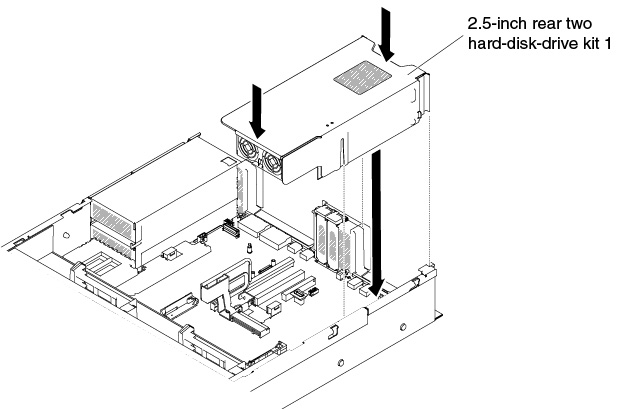Replacing the rear two hard-disk-drive kit
Use this information to replace the rear two hard-disk-drive kit on the system board.
Note
- Refer to the following rules before you install the rear two hard-disk-drive kit.
- 2.5-inch hot-swap hard disk drive model
- Supports one 2.5-inch rear two hard-disk-drive kit, or
- Supports two 2.5-inch rear two hard-disk-drive kits
- 3.5-inch hot-swap hard disk drive model
- Supports one 2.5-inch rear two hard-disk-drive kit, or
- Supports two 2.5-inch rear two hard-disk-drive kits, or
- Supports one 3.5-inch rear two hard-disk-drive kit, or
- Supports one 2.5-inch rear two hard-disk-drive kit and one 3.5-inch rear two hard-disk-drive kit
- 2.5-inch hot-swap hard disk drive model
- Refer to the following rules for the rear two hard-disk-drive kit numbering.
- 2.5-inch hot-swap hard disk drive model
- One 2.5-inch rear two hard-disk-drive kit numberingFigure 1. One 2.5-inch rear two hard-disk-drive kit numbering

- Two 2.5-inch rear two hard-disk-drive kits numberingFigure 2. Two 2.5-inch rear two hard-disk-drive kits numbering

- One 2.5-inch rear two hard-disk-drive kit numbering
- 3.5-inch hot-swap hard disk drive model
- One 2.5-inch rear two hard-disk-drive kit numberingFigure 3. One 2.5-inch rear two hard-disk-drive kit numbering

- Two 2.5-inch rear two hard-disk-drive kits numberingFigure 4. Two 2.5-inch rear two hard-disk-drive kits numbering

- One 3.5-inch rear two hard-disk-drive kit (with or without RAID card) numberingFigure 5. One 3.5-inch rear two hard-disk-drive kit (with or without RAID card) numbering

- One 3.5-inch and one 2.5-inch rear two hard-disk-drive kits numberingFigure 6. One 3.5-inch and one 2.5-inch rear two hard-disk-drive kits numbering

- One 2.5-inch rear two hard-disk-drive kit numbering
- 2.5-inch hot-swap hard disk drive model
To install the rear two hard-disk-drive kit, complete the following steps:
Give documentation feedback




